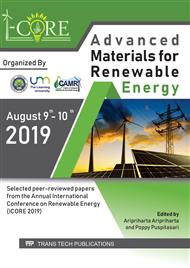[1]
N. Halib, C. Iqbal, M. Amin, and I. Ahmad, Physicochemical Properties and Characterization of Nata de Coco from Local Food Industries as a Source of Cellulose, Sains Malaysiana, 41(2) (2012) 205–211.
Google Scholar
[2]
P. Lestari, N. Elfrida, A. Suryani, and Y. Suryadi, Study on the Production of Bacterial Cellulose from Acetobacter xylinum using Agro-Waste, Jordan J.Biol.Sci., 7(1) (2014) 75–80.
DOI: 10.12816/0008218
Google Scholar
[3]
L. Nuryati and B. Waryonto, Statistik Pertanian Agricultural Statistics, Pusdatin Jakarta, (2016).
Google Scholar
[4]
H. Suryanto, T. A. Sutrisno, M. Muhajir, N. Zakia and U. Yanuhar, Effect of Peroxide Treatment on The Structure and Transparency of Bacterial Cellulose Film, in MATEC Web of Conferences of IMIEC, 204(05015) (2018) 1–6.
DOI: 10.1051/matecconf/201820405015
Google Scholar
[5]
H. Suryanto, M. Muhajir, T. A. Sutrisno, Mudjiono, N. Zakia, and U. Yanuhar, The Mechanical Strength and Morphology of Bacterial Cellulose Films: The Effect of NaOH Concentration, in International Conference on Condensed Matters and Advanced Materials (IC2MAM) 515 (2019) 1–7.
DOI: 10.1088/1757-899x/515/1/012053
Google Scholar
[6]
S. Wang, X. Peng, L. Zhong, J. Tan, S. Jing, X. Cao, W. Chen, C. Liua and R. Sun, An ultralight, elastic, cost-effective, and highly recyclable superabsorbent from microfibrillated cellulose fibers for oil spillage cleanup, J. Mater. Chem. A, 3(16) (2015) 8772–8781.
DOI: 10.1039/c4ta07057g
Google Scholar
[7]
R. Strey, M. Klostermann, L. Kramer, R. Schwering, and T. Sottmann, Sugar micro/nanofoams, US 20110174192 A1, (2011).
Google Scholar
[8]
T. Fujii, T. Yano, K. Nakamura, and O. Miyawaki, The sol–gel preparation and characterization of nanoporous silica membrane with controlled pore size, J. Memb. Sci., 187(1) (2001) 171–180.
DOI: 10.1016/s0376-7388(01)00338-6
Google Scholar
[9]
V. Consuelo, R. Schmidt, and J. B. Laurindo, Characterization of Foams Obtained from Cassava Starch, Cellulose Fibres and Dolomitic Limestone by a Thermopressing Process, Arch. Biol. Technol. v, 53153(1) (2010) 185–192.
DOI: 10.1590/s1516-89132010000100023
Google Scholar
[10]
M. Sjoqvist and P. Gatenholm, The Effect of Starch Composition on Structure of Foams Prepared by Microwave Treatment, J. Polym. Environ., 13(1) (2005) 29–37.
DOI: 10.1007/s10924-004-1213-8
Google Scholar
[11]
A. Lopez-Gil, F. Silva-Bellucci, D. Velasco, M. Ardanuy, and M. A. Rodriguez-Perez, Cellular structure and mechanical properties of starch-based foamed blocks reinforced with natural fibers and produced by microwave heating, Ind. Crops Prod., 66(66) (2015) 194–205.
DOI: 10.1016/j.indcrop.2014.12.025
Google Scholar
[12]
R. Sescousse, R. Gavillon, and T. Budtova, Aerocellulose from cellulose–ionic liquid solutions: Preparation, properties and comparison with cellulose–NaOH and cellulose–NMMO routes, Carbohydr. Polym., 83(4) (2011) 1766–1774.
DOI: 10.1016/j.carbpol.2010.10.043
Google Scholar
[13]
D. Qian, P. R. Chang, and X. Ma, Preparation of controllable porous starch with different starch concentrations by the single or dual freezing process, Carbohydr. Polym., 86(3) (2011) 1181–1186.
DOI: 10.1016/j.carbpol.2011.06.012
Google Scholar
[14]
J. M. Lagarón, A. López-Rubio, and M. José Fabra, Structural and mechanical properties of clay nanocomposite foams based on cellulose for the food-packaging industry, J. Appl. Polym. Sci., 133(2) (2016) 42079.
DOI: 10.1002/app.42971
Google Scholar
[15]
T. Mahsuli, H. Suryanto, A. Larasati, and M. Muhajir, Mechanical properties of bacterial nanocellulose membrane from pineapple peel waste after homogenization process, AIP Conf. Proc., 50019(50019) (2019) 1–5.
DOI: 10.1063/1.5115695
Google Scholar
[16]
H. Suryanto, S. Sukarni, Y. Rohmat, A. Pradana, U. Yanuhar, and K. Witono, Effect of mercerization on properties of mendong (Fimbristylis globulosa) fiber,, Songklanakarin J. Sci. Technol., 41 (2019) 624–630.
DOI: 10.1007/978-3-319-44570-0_3
Google Scholar
[17]
H.P.S. Abdul Khalil, Y. Davoudpour, Md. Nazrul Islama, A. Mustapha, K. Sudesh, R. Dungani and M. Jawaid, Production and modification of nanofibrillated cellulose using various mechanical processes: A review, Carbohydr. Polym., 99 (2014) 649–665.
DOI: 10.1016/j.carbpol.2013.08.069
Google Scholar
[18]
M. Le Troedec, D. Sedan, C. Peyratout, J. P. Bonnet, and S. Agnes, Influence of various chemical treatments on the composition and structure of hemp fibres, Compos. Part A, 39 (2008) 514–522.
DOI: 10.1016/j.compositesa.2007.12.001
Google Scholar
[19]
H. Suryanto, A. A. Fikri, A. A. Permanasari, U. Yanuhar, and S. Sukardi, Pulsed Electric Field Assisted Extraction of Cellulose From Mendong Fiber (Fimbristylis globulosa) and its Characterization, J. Nat. Fibers, 15(3) (2018) 406–415.
DOI: 10.1080/15440478.2017.1330722
Google Scholar
[20]
S. A. Sardjono, H. Suryanto, Aminnudin, and M. Muhajir, Crystallinity and morphology of the bacterial nanocellulose membrane extracted from pineapple peel waste using high-pressure homogenizer, AIP Conf. Proc., 2120 (2019).
DOI: 10.1063/1.5115753
Google Scholar
[21]
R. Auta, G. Adamus, M. Kwiecien, I. Radecka, and P. Hooley, Production and characterization of bacterial cellulose before and after enzymatic hydrolysis, African J. Biotechnol., 16(10) (2017) 470–482.
Google Scholar


